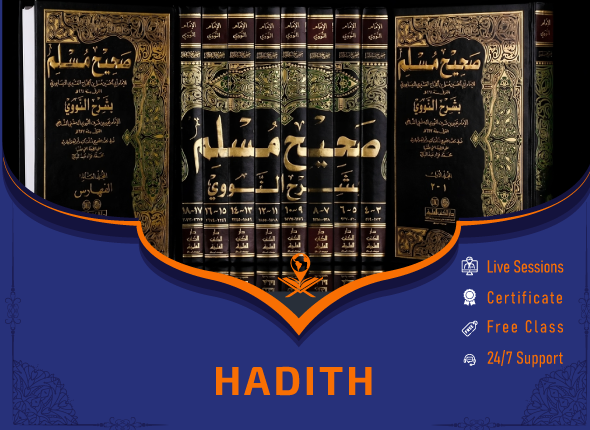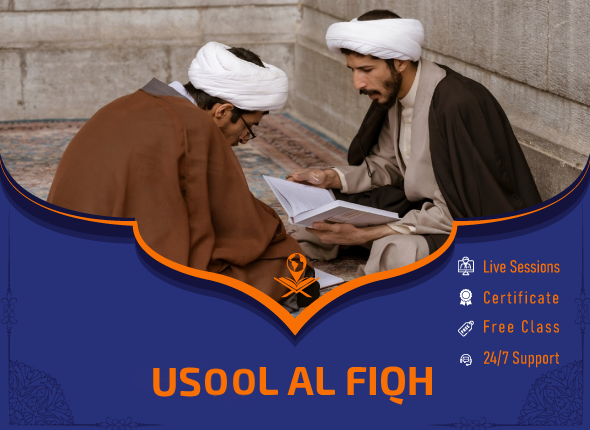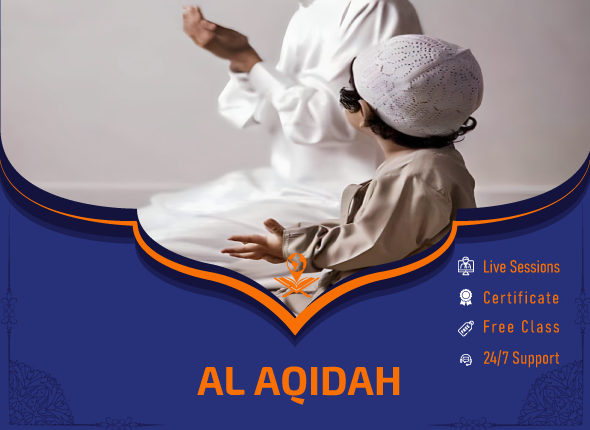
Hadith Course
Course description
The knowledge of hadith according to the imams of this knowledge is divided into two parts: the first: the science of hadith Riwaya, and the second: the science of hadith Dirayah, and the first section is the text of the hadith itself, or its text, which is what was added to the Prophet, may Allah bless him and grant him peace, or to a companion, from the standpoint of care taken to transmit it. That, controlling it, and editing its words. The second section is the science of hadith, which is a science in which the conditions of the narrator and the narrated are researched in terms of acceptance and refutation, which is known as the chain of transmission of the hadith.
The science of hadith Riwaya that includes controlling the hadith, transmitting it, narrating it, and editing its words. Among the books of this type are: the two Sahihs and the four Sunans, as well as the Musnads, dictionaries, and hadith parts.
The science of hadith Dirayah, which is the knowledge by which the truth of the narration, its conditions, types, rulings, the condition of the narrators, their conditions, and the types of narrations and their jurisprudence. This knowledge serves the first type. The scholars said: “The knowledge that is specific to knowledge clarifies that which is specific to narration.”
It is known and agreed upon by the scholars of hadith that the subject of hadith is concerned with knowing the chain of transmission and the text together. As for the chain of transmission, in terms of the conditions of its individuals and narrators, its continuity or discontinuity, its rise or descent, and so on, and as for the text, in terms of its authenticity or weakness, and what is related to that, it is also known that the benefit of the science of hadith is: knowing the authentic hadith and distinguishing it from the weak hadith in which there is a defect, and knowing the acceptable hadith from The answer is that the purpose of the science of hadith is knowledge that by it the religion is preserved from distortion and alteration, so through it we distinguish between authentic and invalid hadiths. If it were not for it, the authentic hadith would have been mixed with the weak and fabricated ones, and the words of the Messenger of Allah, may Allah bless him and grant him peace, would have been mixed with the words of others. For this reason, Ibn Sayyid al-Nas’s is named as definition of the scholar who studies the Riwaya and Dirayah of hadith, and was acquainted with many narrators and narrations in his time, and excelled in that until his handwriting was known and he was famous for his precision. Al-Hakim said: “The authentic hadith is not known by its narration alone, but rather by understanding, memorization, and frequent listening.”
The knowledge of hadith can be divided in detail into:
1) knowledge of Al-Mustalah: It is a science by which the state of the narrator and narratee is known in terms of acceptance and rejection.
2) knowledge of Al-Takhrij: It is a science that specializes in indicating the location of the hadith in its original sources in the books of the Sunnah and highlighting it to the people, along with clarifying the rank of the hadith when necessary.
3) knowledge of Al-Rijal(al-jarh wa al-ta’deel): It is knowledge of the conditions of hadith narrators in terms of acceptance and refutation.
4) knowledge of Al-ills: It is the science that criticizes the hadiths of trustworthy people in which there has been an illusion or a hidden error, and it is one of the most accurate and most difficult sciences.
____________________________________________________________________
[Terminology of Hadith Science:]
Mutawatir: What was narrated by a large group of people from a large group such that habit or reason would make it impossible for them to conspire to lie.
Ahaad: What lacks one of the conditions of frequency.
Hadith Qudisi: What the Prophet – may God bless him and grant him peace – narrates on the authority of his Lord – the Almighty – in word or meaning other than the Qur’an.
Hadith Marfu’ : What was added to the Prophet – may God bless him and grant him peace – in terms of words, actions, reports, or descriptions.
Hadith Mawquf: what was added by a companion of words, actions, or reports, whether continuous or interrupted.
Hadith Munqati’: what was added to the followers and those below them as being linked to them from their words and actions.
Hadith Sahih Lizatih(according to itself): that whose chain of transmission is connected to the transmission of perfectly precise justice from a similar one to its end, without anomalies or defects.
Hadith Sahih Lighaireh (according to others): It is a hadith that is good in itself if it is narrated from another way similar to it or stronger than it.
Hadith Al-Hasan Lizatih (to itself): It is the hadith whose chain of transmission is linked to a just and light-hearted transmission without any anomalies or defects.
Hadith Hasan Lighaireh (according to others): It is a weak hadith if it has multiple paths and it can be replaced by something else.
Hadith Daieef: It is a hadith that lacks one of the conditions of acceptable hadith, and falls short of the rank of hasan.
Hadith Mawdu’: It is false and fabricated news that is falsely attributed to the Messenger of God – may God bless him and grant him peace.
Hadith Martuk: It is a hadith whose chain of transmission has a narrator accused of lying and the hadith is known only from his source.
Hadith Shaaz: What was narrated by a trustworthy narrator that contradicts someone who is more trustworthy than him.
Hadith Munkar: It is what was narrated by a weak narrator that is not trustworthy.
Hadith Mudtarib: It is something that was changed in the context of its chain of transmission or included in its text something that is not part of it.
Hadith Musahhaf: It is a hadith that is narrated in different ways that are not likely to be combined, and it is not possible to combine them.
Hadith Muttasil: It is changing the word in the hadith from the correct form to another.
Hadith Mounqati: one in which none of its narrators, whether traceable or traceable, has omitted from its chain of transmission.
Hadith Mounqati: It is one or more narrators whose chain of transmission was dropped before the Companion, not consecutively.
Hadith Mu’allaq: What one or more narrators are deleted from the beginning of its chain of transmission, or the entire chain of transmission is deleted, or all of the chain of transmission is deleted except for the Companion.
Hadith Muaddal: It is one whose chain of transmission was omitted by two or more narrators in succession.
Hadith Mursal: What the Tabi’i, whether young or old, transmitted to the Prophet – may God bless him and grant him peace – by saying: The Messenger of God – may God bless him and grant him peace – said, or it is: what was omitted from the end of its chain of transmission after the Tabi’i.
Hadith Mudallas: There are two types:
The first: Fraudulent attribution: It is for the narrator to narrate from someone he met something that he did not hear from him, giving the illusion that he heard it from him.
The second: deception of the sheikhs: it is when the narrator narrates a hadith from a sheikh that he heard from him, and then names him, nicknames him, attributes him, or describes him in a way that he does not know; So that he would not be known due to his weakness, youth, or the like.
Hadith Mudallas Khafi (hidden): It is the hadith that the narrator narrates from someone who lived with him but did not meet him.
These are the most prominent terms related to the science of hadith.
[The Importance of studying the science of hadith and its benefits:]
1) Knowing the status of the Sunnah, which is the second source of legislation, and is explained in the Qur’an. And detailed as a whole.
2) Preserving the Islamic religion from distortion and alteration. The nation has transmitted the Prophet’s hadith with chains of transmission, and has distinguished the authentic from the inauthentic, and had it not been for this knowledge, the authentic hadith would have been confused with the weak and fabricated, and the words of the Messenger would have been mixed with the words of others, and the sciences of Sharia and the rulings of religion would have been lost.
3) Knowing the methods of scholars and hadith scholars in confirming the hadith and purifying it from the intrusive, through the disciplined criteria they have established and the venerable rules that combine the sound approach and scientific honesty.
4) The principles of this science save the world from the danger of the great threat that befalls those who are lenient in narrating the hadith
5) This knowledge gives its possessors a great benefit in purifying minds and precise consideration in knowing the authentic hadith from the incorrect, and distinguishing what is authentic from what is not.
6) This science opens the way for researchers to investigate the meanings of texts and understand their contents, then be confident in citing them in all different sciences.
7) Knowing the conditions of the men of hadith and their classes.
8) Knowing the method of grading hadiths and verifying their chains of transmission.
9) Hadith science extends its influence to other Islamic sciences.









